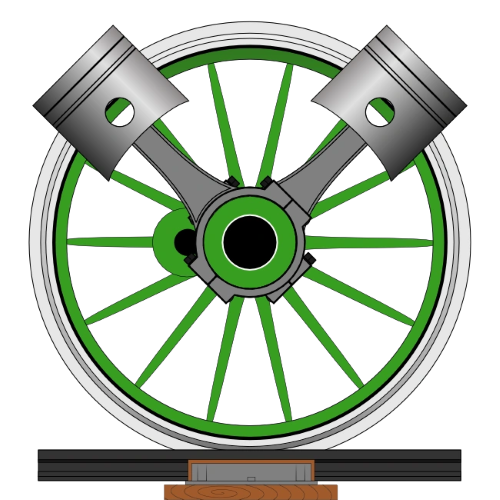The New South Wales C36 (known as 36s) class were a class of steam locomotives built by for the New South Wales Government Railways in Australia. First introduced in 1925, the 75 locomotives produced became the main locomotives in use for all major express train routes, and accelerated long distance passenger timetables leading to new routes of service in the pre World War II period. They were the mainstay of passenger expresses for over 20 years before the introduction of the 38 class. The class was used extensively for performance testing, and thus the development and trial of a number of technical improvements.
Origins and Development[]
The 36 class was a relatively minor improvement of the 35 class locomotives, which were introduced in 1914. The first ten were built by the Railway Workshops in Eveleigh, the remaining 65 by Clyde Engineering. The design was built in response to the increased loading of express trains and public demand for quicker journeys, as well as to the need for reduced servicing and lower maintenance costs. All locomotives were superheated from the outset. The 36 class in its original form had a round-top boiler. In the 1950s, the majority of the 36s were rebuilt with new, all-steel Belpaire boilers and had their cabs redesigned. Typical of the technology of the 1950s, the riveted steel boilers originally fitted to the class had copper inners in the fireboxes, fire-tubes and superheater flues. The replacement Belpaire boilers had steel fireboxes, tubes and flues, which was used because of US practice and NSWGR policies which were enacted later. Although copper provided the more superior heat transfer than steel, it promoted an electrochemical reaction that resulted in the galvanic corrosion of some boiler components that were made of steel such as crown stays and front tubeplates. The 36 class was fitted with Walschaerts valve gear, and most subsequent steam classes followed suit. Many of the old express train drivers claimed the 36 class were faster than the 38 class which arrived in later years, and were reputed to have reached speeds of over 160 kilometres per hour.
In Service[]
The 36 class locomotives were scheduled to operate on express passenger services, initially on the premier Newcastle Flyer trains, then were rolled out onto Southern and Northern expresses and mail trains. The increased range of the 36 class was trialled early into its period of service, with through trips from Sydney Central to Albury, a distance of some 400 miles, without changing the locomotive. By the late 1920s, the class were in regular use on the Melbourne Limited and Melbourne Express, generally with only four stops on the route. On the Main North Line they worked trains as far as Armidale and on the North Coast to South Grafton. Following the construction of the Grafton Bridge over the Clarence River, the 36 class worked all the way to South Brisbane. When the Central West Express, Northern Tablelands Express and Riverina Express were introduced in 1941, the 36 class were rostered on these routes. By the 1950s the 38 class were running on all major expresses, and the 36 class were used on slower passenger services and mail trains instead, including to Albury, Narrandera, Dubbo, Parkes, Thirroul, Armidale and South Brisbane and local stopping trains on the Main North Line to Newcastle. Following the electrification of the Main Western line to Lithgow in 1957, some 36 class locomotives were stored at Lithgow, Bathurst and Parkes, and with the introduction of diesel locomotives, were used to haul to freight trains, although they did continue to haul the Central West Express to the west of Lithgow until at least 1963. As well as providing faster services, useful for perishable goods, the rostering of the 36 class on freight services allowed the withdrawal of numbers of Standard Goods locomotives. Withdrawal of the 36 class commenced in January 1959 as more diesels locomotives entered service, but a number were temporarily returned to traffic in late 1966, to work wheat trains after a very large harvest. The last 36 was withdrawn in September 1969. When the 36 class locomotives were delivered, all of the class were painted in standard unlined black. For the 1927 Royal Tour of the Duke and Duchess of York, 3602, 3615, 3616 & 3617 were painted in Royal Blue, with yellow and black lining. In 1934 to operate the Southern Highlands Express, locomotive 3633 was repainted green. Subsequently another 28 locomotives were also painted green. World War Two austerity meant steam locomotives were only painted black, and as the 36 class became due for repainting, they reverted to a plain black livery which they would carry until withdrawn. In 1957 a Giesl Oblong Ejector was fitted to 3616, replacing the blast-pipe and chimney.
Preservation[]
- 3609 by the New South Wales Rail Transport Museum, Thirlmere
- 3616 by the New South Wales Rail Transport Museum transferred from Thirlmere to Goulburn Roundhouse in 2009
- 3642 by the New South Wales Rail Transport Museum withdrawn 1973, restored to service by the State Rail Authority at Goulburn Roundhouse November 1981, withdrawn 1996, restored to traffic 2008
References[]
| Articles on Trains in NSW |
|---|
| 27 Class - 36 Class - 38 Class - 43 Class - XPT |
